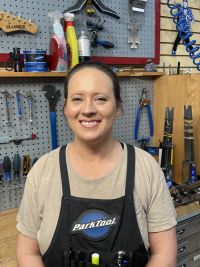A version of this article ran in the September issue of Bicycle Retailer & Industry News.
BOULDER, Colo. (BRAIN) — For our September magazine edition, we asked our State of Retail panel members: Describe your store's social media usage and how it’s changed since the pre-COVID period?
CINCINNATI: David Bordewisch, manager Biowheels

Our social media is approximately 20% of our marketing efforts. We have a very diverse clientele, so we use social media to highlight new bicycles and allow others to see what we have in inventory. We also show happy customers with their new bicycles. Almost everything we do is on Instagram and Facebook; other than adding some "reels," we haven’t branched out to new platforms. Most of our content is self-generated, managed by one person on staff. Post COVID, we are more consistent in regularly posting new content.
Our best practices are: Think about things before you post them. Stay away from politics and social commentary. Update frequently and make sure something is posted at least once a week. Be selective on reposting because original content garners much more interest. We do not directly track or monitor the return on investment of our social media, but when the new Pinarello "F" was posted, we received some leads that were productive. However, the number of potentially fraudulent inquiries also went way up.
WESTLAKE VILLAGE, Calif.: Linda Coburn, co-owner Pedego 101 Electric Bikes

We continue to invest heavily in Google Adwords as our primary source of marketing and advertising. Nothing else we've tried over eight years have been as successful as that ... and good old word-of-mouth from satisfied customers. That said, we are very active on Facebook, moderately active on Instagram, and we occasionally post on Twitter. We also have a private Facebook group for our local owners. Most of our content is posted by the store owners. We take photos of people when we deliver their bikes, when we do group rides, when we have special events. We tried outsourcing once but were not pleased with the relevance of posts. I wouldn't say we made any real changes to our social media strategy due to COVID. Since we don't sell online, it's hard to track any kind of return on investment. We've tried Facebook ads but have seen zero return from that.
FRAMINGHAM, Mass.: Francisco Cornelio, manager https://www.nplusonecyclery.com

Since the pandemic started, we’ve increased our traffic on social media by about 60%, and it continues to thrive. We have also learned more about algorithms. The platforms we use are primarily Facebook and Instagram, but we also have a Twitter account, and we are trying to be more active there too. I personally manage our postings and typically will post three, four and sometimes 10 times a day. From time to time, we pay for advertising on Instagram, Facebook, and WhatsApp, and we usually get very good results. I’ve learned that you have to be consistent in posting, and it takes a few months to get the hang of it. It took about several months for people to start following and liking us. Now we get a good flow of newcomers.
ALTO, Ga.: Joe Elam, owner Habersham Bicycles

We have synced our shop’s Facebook, Twitter, and Instagram accounts, which means we post once to Facebook and it’s automatically sent to the other accounts. I mostly rely on Promoboxx to generate our content. Its automation ensures we have content on a somewhat regular basis, and we create our own posts when we have special announcements such as new product or special hours. Promoboxx has been my only real strategy for social media, and this has not changed either pre- or post-COVID. I have not moved into any new platforms, and I still view Facebook as the standard platform for marketing purposes.
In the early days of social media, I paid for advertising and tried to track its return; however, I have discontinued that because I was never able to justify the paid advertising as to any return in sales or even new customers. I’ve always heard that marketing should be budgeted at a rate at or about 2% of income, but in my experience, most of the dollars spent on advertising rarely have a return worth the investment. The more social media grows, the more I am of the opinion that local is local and word of mouth is most important.
FOLSOM, Calif.: Erin Gorrell, owner Folsom Bike

Social media is extremely important to our sales and marketing as we can reach our audience instantly. We absolutely track the return on our investment, and like any facet of a business, we constantly review, adapt and modify it. Our goal is to create content that is compelling and applicable to our customers’ needs and that it is focused on getting them to ride their bikes. We try to be diverse in our messaging to meet all levels of riders and provide information and storylines where the customer can envision themselves in the story we are sharing. We want to make them want to ride their bike by providing routes, "how to's" and of course, the latest and greatest products available to them. We do all of our social media and marketing in-house as we are very specific about our message and imagery. While our social media output has always been on the daily, we increased a bit during and since COVID, providing local cycling routes every week to help our customers explore places they may not have known about. We did not modify the platforms we utilized; we just amplified it a bit.
Note: Folsom Bike co-owner Erin Gorrell no longer will be on the panel after this month following the sale of her two stores to Trek Bicycle, effective Sept. 1.
PORTLAND, Ore.: Tom Martin, sole proprietor TomCat Bikes

My primary social media account for my shop is Instagram, with a Facebook integration. I do all the content creation myself via a smartphone app. I’m a terrible photographer, but it works with the anti-marketing “dive bar” vibe of the shop. Social media is gamed towards short videos and I’m resisting that because it requires more resources, better lighting, and a faster learning curve. I only have so much time. My use of social media marketing did not change during COVID, but I place a higher value on it than a lot of shops it seems because I post a couple times a week. I measure my return on investment through metrics like appointments booked directly from the platform and closing sales via Messaging. Social media is best as a local-to-your-market tool. My advice is not to be shy about tagging other businesses that are complementary — even other shops — as they will reciprocate if they are smart. Also, be sure to auto follow any follower that has 1,000-plus followers because it will bring other customers due to the algorithms.
HATTIESBURG, Miss.: Jenny Moore, co-owner/manager Moore’s Bicycle Shop

Our current use of social media includes Facebook and Instagram. I post to social media alone but encourage ideas from staff members. Our content includes sharing local cycling events, introducing new showroom merchandise, and other positive content I run across. With the steady volume of customers in the shop, I've had less time to focus on creating content, and our social media activity has decreased compared to the early days of COVID. Fortunately, our alternate advertising strategies are successfully keeping business steady. I've tried sharing unique and popular items on our social media and have not seen consistent results, but I remember years ago being stuck with a StreetStrider that needed to go. The staff and I made a short video demonstrating its use, and the next morning two parties arrived fighting over it.
CHAMPLIN, Minn.: Pam Sayler, owner Trailhead Cycling

We utilize Facebook and Instagram, adding posts every two to three days. Our Facebook content tends to be more detailed, and the Instagram content is more image/headline-focused. Most of our posts originate from me, but our shop ambassadors add ride updates and event information. The social separation of COVID drove social media deeper into our lives. It became necessary to dedicate time on Facebook Messenger, and we find that adapting to how consumers communicate is the biggest modification we've made in our social media usage since the pandemic. We think social media is extremely important to our sales and marketing, and Facebook provides excellent tools for tracking impressions, clicks, and likes. Not doing anything for social media for your shop is a failure. Try something. Learn from your mistakes, then try again. And also, add an email platform — use Instagram for images and Facebook for more detail and email for engaging content.


